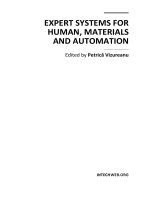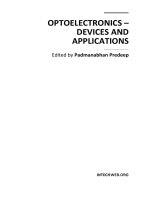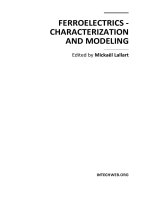Ferroelectrics Characterization and Modeling Part 1 pdf
Bạn đang xem bản rút gọn của tài liệu. Xem và tải ngay bản đầy đủ của tài liệu tại đây (2.83 MB, 35 trang )
FERROELECTRICS -
CHARACTERIZATION
AND MODELING
Edited by Mickaël Lallart
Ferroelectrics - Characterization and Modeling
Edited by Mickaël Lallart
Published by InTech
Janeza Trdine 9, 51000 Rijeka, Croatia
Copyright © 2011 InTech
All chapters are Open Access articles distributed under the Creative Commons
Non Commercial Share Alike Attribution 3.0 license, which permits to copy,
distribute, transmit, and adapt the work in any medium, so long as the original
work is properly cited. After this work has been published by InTech, authors
have the right to republish it, in whole or part, in any publication of which they
are the author, and to make other personal use of the work. Any republication,
referencing or personal use of the work must explicitly identify the original source.
Statements and opinions expressed in the chapters are these of the individual contributors
and not necessarily those of the editors or publisher. No responsibility is accepted
for the accuracy of information contained in the published articles. The publisher
assumes no responsibility for any damage or injury to persons or property arising out
of the use of any materials, instructions, methods or ideas contained in the book.
Publishing Process Manager Silvia Vlase
Technical Editor Teodora Smiljanic
Cover Designer Jan Hyrat
Image Copyright Noel Powell, Schaumburg, 2010. Used under license from
Shutterstock.com
First published July, 2011
Printed in Croatia
A free online edition of this book is available at www.intechopen.com
Additional hard copies can be obtained from
Ferroelectrics - Characterization and Modeling, Edited by Mickaël Lallart
p. cm.
ISBN 978-953-307-455-9
free online editions of InTech
Books and Journals can be found at
www.intechopen.com
Contents
Preface IX
Part 1 Characterization: Structural Aspects 1
Chapter 1 Structural Studies in
Perovskite Ferroelectric Crystals Based
on Synchrotron Radiation Analysis Techniques 3
Jingzhong Xiao
Chapter 2 Near-Field Scanning Optical Microscopy
Applied to the Study of Ferroelectric Materials 23
Josep Canet-Ferrer and Juan P. Martínez-Pastor
Chapter 3 Internal Dynamics of the
Ferroelectric (C
3
N
2
H
5
)
5
Bi
2
Cl
11
Studied by
1
H NMR and IINS Methods 41
Krystyna Hołderna-Natkaniec,
Ryszard Jakubas and Ireneusz Natkaniec
Chapter 4 Structure – Property Relationships of Near-Eutectic
BaTiO
3
– CoFe
2
O
4
Magnetoelectric Composites 61
Rashed Adnan Islam, Mirza Bichurin and Shashank Priya
Chapter 5 Impact of Defect Structure on
’Bulk’ and Nano-Scale Ferroelectrics 79
Emre Erdem and Rüdiger-A. Eichel
Chapter 6 Microstructural Defects in
Ferroelectrics and Their Scientific Implications 97
Duo Liu
Part 2 Characterization: Electrical Response 115
Chapter 7 All-Ceramic Percolative
Composites with a Colossal Dielectric Response 117
Vid Bobnar, Marko Hrovat, Janez Holc and Marija Kosec
VI Contents
Chapter 8 Electrical Processes in Polycrystalline BiFeO
3
Film 135
Yawei Li, Zhigao Hu and Junhao Chu
Chapter 9 Phase Transitions in
Layered Semiconductor - Ferroelectrics 153
Andrius Dziaugys, Juras Banys, Vytautas Samulionis,
Jan Macutkevic, Yulian Vysochanskii,
Vladimir Shvartsman and Wolfgang Kleemann
Chapter 10 Non-Linear Dielectric Response of
Ferroelectrics, Relaxors and Dipolar Glasses 181
Seweryn Miga, Jan Dec and Wolfgang Kleemann
Chapter 11 Ferroelectrics Study at Microwaves 203
Yuriy Poplavko, Yuriy Prokopenko,
Vitaliy Molchanov and Victor Kazmirenko
Part 3 Characterization: Multiphysic Analysis 227
Chapter 12 Changes of Crystal Structure and Electrical Properties
with Film Thickness and Zr/(Zr+Ti) Ratio for Epitaxial
Pb(Zr,Ti)O
3
Films Grown on (100)
c
SrRuO
3
//(100)SrTiO
3
Substrates by Metalorganic Chemical Vapor Deposition 229
Mohamed-Tahar Chentir, Hitoshi Morioka,
Yoshitaka Ehara, Keisuke Saito, Shintaro Yokoyama,
Takahiro Oikawa and Hiroshi Funakubo
Chapter 13 Double Hysteresis Loop in
BaTiO
3
-Based Ferroelectric Ceramics 245
Sining Yun
Chapter 14 The Ferroelectric Dependent
Magnetoelectricity in Composites 265
L. R. Naik and B. K. Bammannavar
Chapter 15 Characterization of Ferroelectric
Materials by Photopyroelectric Method 281
Dadarlat Dorin, Longuemart Stéphane and Hadj Sahraoui Abdelhak
Chapter 16 Valence Band Offsets of ZnO/SrTiO
3
, ZnO/BaTiO
3
,
InN/SrTiO
3
, and InN/BaTiO
3
Heterojunctions
Measured by X-Ray Photoelectron Spectroscopy 305
Caihong Jia, Yonghai Chen, Xianglin Liu,
Shaoyan Yang and Zhanguo Wang
Part 4 Modeling: Phenomenological Analysis 325
Chapter 17 Self-Consistent Anharmonic
Theory and Its Application to BaTiO
3
Crystal 327
Yutaka Aikawa
Contents VII
Chapter 18 Switching Properties of Finite-Sized Ferroelectrics 349
L H. Ong and K H. Chew
Chapter 19 Intrinsic Interface Coupling in
Ferroelectric Heterostructures and Superlattices 373
K H. Chew, L H. Ong and M. Iwata
Chapter 20 First-Principles Study of ABO
3
:
Role of the B–O Coulomb Repulsions
for Ferroelectricity and Piezoelectricity 395
Kaoru Miura
Chapter 21 Ab Initio Studies of
H-Bonded Systems: The Cases of
Ferroelectric KH
2
PO
4
and Antiferroelectric NH
4
H
2
PO
4
411
S. Koval, J. Lasave, R. L. Migoni, J. Kohanoff and N. S. Dalal
Chapter 22 Temperature Dependence
of the Dielectric Constant Calculated
Using a Mean Field Model Close to the
Smectic A - Isotropic Liquid Transition 437
H. Yurtseven and E. Kilit
Chapter 23 Mesoscopic Modeling of
Ferroelectric and Multiferroic Systems 449
Thomas Bose and Steffen Trimper
Chapter 24 A General Conductivity Expression
for Space-Charge-Limited Conduction in
Ferroelectrics and Other Solid Dielectrics 467
Ho-Kei Chan
Part 5 Modeling: Nonlinearities 491
Chapter 25 Nonlinearity and Scaling
Behavior in a Ferroelectric Materials 493
Abdelowahed Hajjaji, Mohamed Rguiti, Daniel Guyomar,
Yahia Boughaleb and Christan Courtois
Chapter 26 Harmonic Generation in Nanoscale Ferroelectric Films 513
Jeffrey F. Webb
Chapter 27 Nonlinear Hysteretic
Response of Piezoelectric Ceramics 537
Amir Sohrabi and Anastasia Muliana
Chapter 28 Modeling and Numerical
Simulation of Ferroelectric Material
Behavior Using Hysteresis Operators 561
Manfred Kaltenbacher and Barbara Kaltenbacher
Preface
Ferroelectricity has been one of the most used and studied phenomena in both scien-
tific and industrial communities. Properties of ferroelectrics materials make them par-
ticularly suitable for a wide range of applications, ranging from sensors and actuators
to optical or memory devices. Since the discovery of ferroelectricity in Rochelle Salt
(which used to be used since 1665) in 1921 by J. Valasek, numerous applications using
such an effect have been developed. First employed in large majority in sonars in the
middle of the 20
th
century, ferroelectric materials have been able to be adapted to more
and more systems in our daily life (ultrasound or thermal imaging, accelerometers, gy-
roscopes, filters…), and promising breakthrough applications are still under develop-
ment (non-volatile memory, optical devices…), making ferroelectrics one of tomor-
row’s most important materials.
The purpose of this collection is to present an up-to-date view of ferroelectricity and its
applications, and is divided into four books:
• Material Aspects, describing ways to select and process materials to make
them ferroelectric.
• Physical Effects, aiming at explaining the underlying mechanisms in ferroelec-
tric materials and effects that arise from their particular properties.
• Characterization and Modeling, giving an overview of how to quantify the
mechanisms of ferroelectric materials (both in microscopic and macroscopic
approaches) and to predict their performance.
• Applications, showing breakthrough use of ferroelectrics.
Authors of each chapter have been selected according to their scientific work and their
contributions to the community, ensuring high-quality contents.
The present volume aims at exposing characterization methods and their application
to assess the performance of ferroelectric materials, as well as presenting innovative
approaches for modeling the behavior of such devices.
The book is decomposed into five sections, including structural and microstructural
characterization (chapters 1 to 6), electrical characterization (chapters 7 to 11), multiphysic
characterization (chapters 12 to 16), phenomenological approaches for modeling the
X Preface
behavior of ferroelectric materials (chapters 17 to 24), and nonlinear modeling (chapters
25 to 28).
I sincerely hope you will find this book as enjoyable to read as it was to edit, and that
it will help your research and/or give new ideas in the wide field of ferroelectric mate-
rials.
Finally, I would like to take the opportunity of writing this preface to thank all the au-
thors for their high quality contributions, as well as the InTech publishing team (and
especially the publishing process manager, Ms. Silvia Vlase) for their outstanding
support.
June 2011
Dr. Mickaël Lallart
INSA Lyon, Villeurbanne
France
Part 1
Characterization: Structural Aspects
1
Structural Studies in
Perovskite Ferroelectric Crystals Based
on Synchrotron Radiation Analysis Techniques
Jingzhong Xiao
1,2
1
CEMDRX, Department of Physics, University of Coimbra, Coimbra,
2
International Centre for Materials Physics,
Chinese Academy of Sciences, Shenyang,
1
Portugal
2
China
1. Introduction
Perovskite oxide materials, having the general formula ABO
3
, form the backbone of the
ferroelectrics industry. These materials have come into widespread use in applications that
range in sophistication from medical ultrasound and underwater sonar systems, relatively
mundane devices to novel applications in active and passive damping systems for sporting
goods and automobiles [1-3]. Recent developments in regard to relaxor-based single crystal
piezoelectrics, such as Pb(Zn
1/3
Nb
2/3
)O
3
–PbTiO
3
(PZNT), Pb(Fe
1/2
Nb
/1/2
)O
3
–PbTiO
3
(PFNT) and Pb(Mg
1/3
Nb
2/3
)O
3
–PbTiO
3
(PMNT) have shown superior performance
compared to the conventional Pb(Zr,Ti)O
3
(PZT) ceramics[4, 5]. Particularly, their ultrahigh
piezoelectric and electromechanical coupling factors in the <001> direction can reach to
d
33
>2000pC/N and k
33
≈94%, which have attracted tremendous interests and still make these
materials very hot.
However, the origin and structural nature of their ultrahigh performances remains one
inquisitive but obscure subject of recent scientific interest.To better understand the
structural nature of the outstanding properties, it is very important for investigating the
ferroelectric domain structure in these materials. In ferroelectrics, according to the electrical
and mechanical compatibility conditions, domain structures of 180
o
and non-180
o
will form
with respect to crystal symmetry. There is a closely relationship between the domain
structure and the crystal symmetry. Through the observation on ferroelectric domain
configurations, the crystal structures can be confirmed. Ferroelectric domains are
homogenous regions within ferroelectric materials in which polarizations lie along one
direction, that influence the piezoelectric and ferroelectric properties of the materials for
utilization in memory devices, micro-electromechanical systems, etc. Understanding the role
of domain structure on properties relies on microscopy methods that can inspect the domain
configuration and reveal the evolution or the dynamic behaviour of domain structure.
It is also well known that the key to solve this issue of exploring the origin of the excellent
properties is to reveal the peculiar complex perovskite crystal structures in these materials.
Through study in structure behavior under high-pressure and local structure at atomic level
will be helpful for better understanding this problem.
Ferroelectrics - Characterization and Modeling
4
2. Synchrotron radiation X-ray structure investigation on ferroelectric
crystals
Pb(Zn
1/3
Nb
2/3
)O
3
-PbTiO
3
(PZNT) and Pb(Fe
1/2
Nb
/1/2
)O
3
–PbTiO
3
(PFNT) crystal are model
ABO
3
-type relaxor ferroelectric materials (or ferroelectrics), which demonstrates excellent
performance in the filed of dielectrics, piezoelectrics, and electrostriction, etc. To explore the
common issues of structural nature and the relationship between structure and performance
of ultrahigh-performance in these materials, in this chapter, the novel X-ray analysis
techniques based on synchrotron radiation light, such as synchrotron radiation X-Ray
topography, high-pressurein situ synchrotron radiation energy dispersive diffraction, and
XAFS method, are utilized to investigate the domain configuration, structure and their
evolution behavior induced by temperature changes and external field.
2.1 Application of white beam synchrotron radiation X-ray topography for in-situ
study of ferroelectric domain structures
Ferroelectric domains can be observed by various imaging techniques such as optical
microscopy, scanning electron microscopy (SEM), transmission electron microscopy (TEM),
X-ray imaging, and etc. Imaging is normally associated with lenses. Unlike visible light or
electrons, however, efficient lenses are not available for hard X-rays, essentially because they
interact weakly with matter. Comparatively as an X-ray imaging method, X-ray topography
plays a vital role in providing a better understanding of ferroelectric domain structure.[6] X-
rays are more penetrating than photons and electrons, and the advent of synchrotron
radiation with good collimation, a continuous spectrum (white beam) and high intensity has
given X-ray topography additional powers. The diffraction image contrast in X-ray
topographs can be accessed from variations in atomic interplanar spacings or interference
effects between X-ray and domain boundaries so that domain structure can be directly
observed (with a micrometer resolution). Especially, via a white beam synchrotron radiation
X-ray diffraction topography technique (WBSRT), one can study the dynamic behaviour of
domain structure and phase evolution in ferroelectric crystals respectively induced by the
changes of sample temperature, applied electric field, and other parameter changes.
In this chapter, a brief introduction to principles for studying ferroelectric domain structure by
X-ray diffraction imaging techniques is provided. The methods and devices for in-situ
studying domain evolution by WBSR are delineated. Several experimental results on dynamic
behavior of domain structure and induced phase transition in ferroelectric crystals accessed at
beam line 4W1A of the Beijing Synchrotron Radiation Laboratory (BSRL) are introduced.
2.1.1 Principle of synchrotron radiation X-ray topography
a. X-ray topography approach
X-ray diffraction topography is an imaging technique based on Bragg diffraction. In the last
decades, X-ray diffraction topography to characterize crystals for the microelectronics
industry were developed and completely renewed by the modern synchrotron radiation
sources. [6]
Its images (topographs) record the intensity profile of a beam of X-rays diffracted by a
crystal. A topograph thus represents a two-dimensional spatial intensity mapping of
reflected X-rays, i.e. the spatial fine structure of a Bragg spot. This intensity mapping reflects
the distribution of scattering power inside the crystal; topographs therefore reveal the
Structural Studies in Perovskite Ferroelectric
Crystals Based on Synchrotron Radiation Analysis Techniques
5
irregularities in a non-ideal crystal lattice. The basic working principle of diffraction
topography is as follows: An incident, spatially extended X-ray beam impinges on a sample,
as shown in Fig.1. The beam may be either monochromatic, or polychromatic (i.e. be
composed of a mixture of wavelengths (white beam topography)). Furthermore, the incident
beam may be either parallel, consisting only of rays propagating all along nearly the same
direction, or divergent/convergent, containing several more strongly different directions of
propagation.
Fig. 1. The scheme of basic principle of diffraction topography.
A homogeneous sample (with a regular crystal lattice) would yield a homogeneous intensity
distribution in the topograph (a "flat" image). Intensity modulations (topographic contrast)
arise from irregularities in the crystal lattice, originating from various kinds of defects such
as cracks, surface scratches, dislocations, grain boundaries, domain walls, etc. Theoretical
descriptions of contrast formation in X-ray topography are largely based on the dynamical
theory of diffraction. This framework is helpful in the description of many aspects of
topographic image formation: entrance of an X-ray wave-field into a crystal, propagation of
the wave-field inside the crystal, interaction of wave-field with crystal defects, altering of
wave-field propagation by local lattice strains, diffraction, multiple scattering, absorption.
Theoretical calculations, and in particular numerical simulations by computer based on this
theory, are thus a valuable tool for the interpretation of topographic images. Contrast
formation in white beam topography is based on the differences in the X-ray beam intensity
diffracted from a distorted region around the defect compared with the intensity diffracted
from the perfect crystal region. The image of this distorted region corresponds to an
increased intensity (direct image) in the low absorption case.
To conduct a topographic experiment, three groups of instruments are required: an x-ray
source, potentially including appropriate x-ray optics; a sample stage with sample
manipulator (diffractometer); and a two-dimensionally resolving detector (most often X-ray
film or camera). The x-ray beam used for topography is generated by an x-ray source,
typically either a laboratory x-ray tube (fixed or rotating) or a synchrotron source. The latter
offers advantages due to its higher beam intensity, lower divergence, and its continuous
wavelength spectrum. The topography technique combinning with a synchrotron source, is
well adapted to in-situ experiments, where the material, in an adequate sample environment
device, is imaged while an external parameter (temperature, electrical field, and etc) is
changed.
Ferroelectrics - Characterization and Modeling
6
Fig. 2. Experimental arrangement for synchrotron radiation white beam Laue topography.
b. White beam X-ray topography
A simple way to understand the creation of X-ray topographic images is to consider a Laue
photograph (Fig. 2). A polychromatic (white) X-ray beam, containing X-ray energies from
about 6 keV to 50 keV (X-ray wavelengths from approximately 2 Å to 0.25 Å), impinges on a
crystal. [6] The beam is diffracted in many directions, creating Laue spots. The positions of
the diffraction spots appear according to the Bragg equation:
2sin
B
hc
E
d
θ
= , or
2sin
B
d
λθ
=
(1)
where E is the incident X-ray energy (and λ is the incident wavelength) selected by crystal
planes with spacing d, h is Planck’s constant, c is the speed of light, and θ
B
is the Bragg angle.
Each spot contains uniform intensity if the crystal is perfect.
If, however, the crystal is strained, streaks appear instead of spots due to variations in lattice
spacing. In fact, each Laue spot contains a spatial distribution of diffracted intensity
attributable to the presence of defects in the crystal. This distributed intensity is difficult to
see because Laue spots are typically the same size as the X-ray beam pinhole, and the
incident X-ray beam is divergent, but each tiny Laue spot is actually an X-ray topograph. At
synchrotron radiation facilities, a collimated white X-ray beam can be used to illuminate a
sample crystal, and spots with the much larger cross section of the synchrotron X-ray beam
are recorded. The resulting data are an array of Laue spots, as shown in Fig. 2, each of which
is an X-ray topograph arising from a different set of atomic planes.
c. Ferroelectric domain characterizations
The existence of antiparallel 180° domains is one of the fundamental properties of
ferroelectrics and direct observation of these domains is invaluable to the understanding of
the polarization reversal mechanism of ferroelectric structures. Among the techniques of
visualizing antiparallel domains, conventional x-ray topography is an important and
efficient method although its application is limited by the only available characteristic
radiations. However, this limitation is easily overcome by the white-beam synchrotron
radiation topography (WBSRT). A unique aspect of WBSRT is the opportunity it affords to
select out of the continuous spectrum any intended wavelengths to activate strong
anomalous scattering. And, with the WBSRT, it is possible for several diffraction images
Structural Studies in Perovskite Ferroelectric
Crystals Based on Synchrotron Radiation Analysis Techniques
7
with anomalous dispersion effect to be activated simultaneously so that the contrast reversal
of 180° domains can be directly observed.[7-9] The natural collimation and high intensity of
the radiation also make the real-time observation of domain dynamics feasible. As shown in
Fig.3, when working with a coherent x-ray beam, and if the phases of the structure factors
are different, the 180° ferroelectric domains can be revealed.
Considering the mechanical and electrical compatibility conditions, allowed domains in
ferroelectrics are the 180o or non-180o ones with the different planes as the domain walls.[8,
9] The extinction condition for a domain wall is:
0PgΔ• = (2)
where g is the reciprocal vector of the diffracting plane,
12
PP PΔ= − is the difference of the
polarization vectors across the domain wall. Non-180
o
domain structure is illustrated in Fig.4.
Fig. 3. (Colour on the web only) Scheme of 180
o
domain.
Fig. 4. Scheme of non-180
o
domain.
2.1.2 In-situ topography measurements
White beam synchrotron radiation topography not only overcomes the drawback of long
exposure time for the conventional x-ray topography, but also extends the scope of
topography study. The excellent collimation and high intensity of the synchrotron radiation
makes the possibility of enlarging the distance between the light source and sample, to
improve the image resolution and enlarge the distance between the sample and the detector.
These allow ones able to install the samples inside large environmental chambers with
changes of temperature, electric field, or other parameters, to carry out the in-situ
topography studies. [10]
Ferroelectrics - Characterization and Modeling
8
a. High temperature condition
A high-temperature chamber was used for in situ topography study. The cylindrical furnace
in use was made of pure graphite. Two beryllium windows were used for incident and
outgoing x-rays. Two thermocouples attached close to the specimen were used to monitor
and control the temperature. A digital control power supply can ramp the electric current
smoothly when starting to heat. The temperature control system is based on the Eurotherm
controller (model 818) and solid state relay (SSR). By using PID control and time proportion
method, the temperature stability is about 0.05°C when holding and 0.1°C when ramping.
The on-line PC can set and monitor the temperature via RS-232 interface. A sketch of this
chamber is shown in Fig. 5.
Fig. 5. Sketch of the high temperature sample chamber: 1-entrance Be window; 2-water
cooling environment chamber; 3-furnace; 4-specimen; 5-exit Be window; 6-film.
Fig. 6. The experimental arrangement for applying electric field.
b. DC electric field
The change of the ferroelectric domain structure due to the applied DC field can also be
observed by white beam synchrotron radiation topography. Fig. 6 is the experimental
arrangement of applying the DC field. The distance between the two electrodes was 4 mm
and the applied DC voltage ranged from 0 to 4400 V. The samples can be installed on the
surface of plastic plates. The DC electrical field can be applied on two Al electrodes covering
on the surface of two X-ray transparent organic materials.
2.1.3 In-situ topography study in ferroelectric crystals
The in-situ experiments are performed at Beijing Synchrotron Radiation Facility (BSRF). The
x-ray topography station and attached 4W1A beamline are part of the BSRF. The 4W1A is a
45m long white/monochromatic wiggler beamline. When the BEPC is operated at the
Structural Studies in Perovskite Ferroelectric
Crystals Based on Synchrotron Radiation Analysis Techniques
9
energy of 2.2 GeV and the magnetic field of the wiggler at 1.8T. The topography station
situated at the end of the beamline 4W1A is mainly used for the study of the perfection of
single crystals, high resolution multi-crystal diffraction and x-ray standing wave research.
The main equipment of the station consists of a white radiation topography camera, three
environmental sample chambers, an x-ray video imaging system and a four crystal
monochromatic camera.
The white radiation topography camera and three environmental sample chambers are used
for the dynamic topographic experiments with change of temperature, stress, electric field
or other parameters. The white radiation camera has five axes to rotate the specimen to any
orientation with the incident beam and to rotate the detector to collect the any diffracted
beam.
a. Domain and temperature-induced phase transformation in 0.92Pb (Zn
1/3
Nb
2/3
)O
3
–
0.08PbTiO
3
crystals
The aim of this present work is to investigate temperature-dependence phase evolution in
0.92Pb (Zn
1/3
Nb
2/3
)O
3
–0.08PbTiO
3
(PZN–8% PT) crystals, by employing a real time white-
beam synchrotron X-ray radiation topography method (WBSRT). By combining this
technique with other complementary structural experiments, a novel picture of low
symmetry phase transformation and phase coexistence is suggested.
PZN–8% PT single crystals used in this experiment were grown by the PbO flux method. A
plate perpendicular to [001] axis is cut and well polished to approximately 200 μm in
thickness. Real time observation is performed at the topography station at the 4W1A beam
line of Beijing Synchrotron Radiation Laboratory (BSRL). The storage ring is 2.2 GeV with
beam current varied from 50 mA to 90 mA. A cylindrical furnace with coiled heating
elements arranged axially around the sample space is used for in situ topography
investigation. After carefully mounted the samples on the hot-stage, we heat them at a slow
rate of 0.5
o
C/min, observe and record the dynamic topography images by photo films.
Through the topography images obtained by this method, we can clearly observe the
ferroelectric domain configurations and their evolution as a function of temperature in
PZN–8% PT crystals.[11]
Fig. 7 shows a series of synchrotron radiation topography images with (112) reflection of the
(001) crystal plate taken at different temperatures. From Fig. 7 (a) to (i), we find that the
domain structures are very complex. They can be categorized into three kinds of domains
and addressed as A, B, and C, as shown in Fig. 7 (j).
The A domain walls, which are at approximately 45
o
to the [100] axis, can be obviously
observed at room temperature. These domain walls are considered to be the 71
o
(or 109
o
)
ones in rhombohedral PZN–PT crystals, and can be clearly observed before heating the
sample to 132
o
C. With increasing temperature from 75
o
C to 131
o
C, as shown in Fig. 7 (b)–
(c), the B domain laminates become progressively obvious and coexist with the A domains.
On the other hand, these domain laminates are along the [010] axis, which can be classified
into 90
o
tetragonal domain walls. At the point of 131
o
C, the tetragonal domains become
most clear. With heating the sample to above 132
o
C, as shown in Fig. 7 (d), we find that the
rhombohedral 71
o
(or 109
o
) domain walls (A laminates) become vague, and the image
background becomes brighter than before. However, the tetragonal domain walls are still
clear. This phenomenon shows that the phase transition from rhombohedral to tetragonal
phase (R–T transition) starts at 75
o
C, and the tetragonal domains grow gradually.
Ferroelectrics - Characterization and Modeling
10
Fig. 7. (Colour on the web only) Images of the in situ synchrotron radiation topography in
PZN–8% PT crystals, the x-rays incident direction to the crystal is [001], the diffraction
vector is g = (112): (a) room temperature (20
o
C); (b) heating to 75
o
C; (c) heating to 131
o
C;
(d) heating to 132
o
C; (e) heating to 190
o
C; (f) heating to 262
o
C; (g) cooling to 190
o
C; (h)
cooling to 75
o
C; (i) cooling to room temperature; (j) Schematic picture for presenting the
ferroelectric domain configurations in the topography images of PZN–8% PT crystals; (k)
enlarged images of C domain walls from 75
o
C to 190
o
C.
Most particularly, a set of unique domain walls (C domain walls) appear at this temperature,
which is quite different from the A and B domains. This kind of domain walls is shown in
Fig.7 (k), through the enlarged images taken from 75
o
C to 190
o
C. As the figures show, the C
domain laminates deviate from the (010) direction at 15
o
–20
o
. According to the knowledge of
domains orientation in crystals with different symmetry and X-ray diffraction extinction
relations, as formula (2) shows, these laminates can be considered to be neither rhombohedral
nor tetragonal domain structures, but a new monoclinic phase domain structure.
With further heating of the system to about 132
o
C, we find this domain structure is very
stable and coexists with B tetragonal domains. Upon further heating to above Tc (170
o
C),
the monoclinic C domain structure also remains. This case shows that a monoclinic phase
not only appears in the process of ferroelectric–ferroelectric phase transformation, but also
coexists with the cubic phase well above TC . With the temperature elevating to about 262
o
C, we find nearly all the ferroelectric domains disappear, as shown in Fig. 7 (f).
Whilst cooling the sample from 262
o
C to 75
o
C, the monoclinic domains (C laminates), as
well as the tetragonal domains (B laminates), are found to reappear, whereas the
rhombohedral domains (A laminates) cannot be recovered by cooling to room temperature.
During the crystal growth, a rapid cooling process was employed for quick crystallization
and to avoid the generation of a pyrochlore phase, which results in a strain field in the
crystal. The rhombohedral A domains are expected to be induced by this kind of strain field
and preserved at room temperature. Thus A domains do not reappear after the crystals are
re-cooled from 260
o
C to room temperature with a slow cooling rate, since this cooling
process possibly releases the crystal strain field. However, the monoclinic phase was not
generated by the strain field induced during the crystal growth, since the particular C
domains as well as B domains can be recovered at 75
o
C by slow cooling.
Structural Studies in Perovskite Ferroelectric
Crystals Based on Synchrotron Radiation Analysis Techniques
11
Generally, with the sample temperature reaches to the Curie temperature, there occurs a
ferroelectric-paraelectric phase transition in conventional ferroelectrics, which results in the
disappearance of the domain structure. However in relaxor ferroelectrics, as shown in Fig. 8
the domain structure can be observed clearly on (111) face of PZN-8%PT crystal when the
sample temperature is much higher than the Curie temperature. This phenomenon can be
induced by the micro-polarization-region in relaxor crystals.
Through in situ synchrotron radiation topography under various temperatures, the complex
configuration and dynamic evolution of ferroelectric domains in ferroelectric crystals are
obtained. It is expected that the present results will encourage more research interest in
exploring the origin of the ultra-high piezoelectric and electrostriction properties in
ferroelectrics and other advanced materials.
Fig. 8. (Colour on the web only) The temperature induced evolution of the domain structure
on (111) face of PZN-8%PT crystal, observed by in situ synchrotron radiation topography.
b. Electrical field induced domain structure
The Gd
2
(MoO
4
)
3
(GMO) crystals were grown by the induction-heated CZ technique. The (0 0
1) crystal pieces of 10–15mm diameter were cut and polished into 2.0 or 0.5mm in
thickness. The transparent pieces were using to study the DC electric field induced domain
structure by transmission X-ray topography at beam line 4W1A of the Beijing Synchrotron
Radiation Laboratory (BSRL) The change of the domain structure due to the applied DC
field was also observed. Fig. 6 is the experimental arrangement of applying the DC field.
The distance between the two electrodes was 4mm and the applied DC field ranged from 0
to 4400 V.
Fig. 9. The domain structure of GMO varies with the applied DC field.
Ferroelectrics - Characterization and Modeling
12
Fig. 9 is a set of series topographs when an applied DC field was added on the GMO crystal
piece. Fig. 9 (a) and (b) are the results obtained when the applied voltage was 600 and 700 V,
respectively, and the domain structure did disappear. Fig. 9 (c) was the result when the
voltage was lowered to zero. From these photographs, we concluded that the multidomain
could be transformed to single domain by applying a DC field and that the single domain
could be kept even if the applied DC field was taken away. This experimental result shows
us that it is possible to make a periodically poled GMO crystal, despite the presence of
ferroelectric and ferroelastic domains in the unpoled GMO crystal. From these results, we
concluded that the ferroelectric and ferroelastic multidomains could be transformed to a
single domain by the applied DC field, and the single domain could be kept even if the
applied DC field was taken away.[12]
2.2 High-pressure structural behavior in PZN-PT relaxor ferroelectrics
The ideal structure of ABO
3
-type perovskite can be described as a network of corner-linked
octahedra, as shown in Fig.10. With B cations at the centre of the octahedra and A cations in
the space (coordination 12) between the AO
12
and BO
6
polyhedra. As its B cation comprised
by Zn
2+
, Nb
5+
, and Ti
4+
ions, as well as the A cation comprised by Pb
2+
ion, PZNT deviates
from the ideal perovskite by cation displacements or a rotation (or tilting) of BO
6
octahedra.
The possible ‘‘off-centering’’ of the B cations makes the crystal structure more complex than
that of the ideal ABO
3
-type perovskites and reasonably influence the properties. Previously,
approaches towards the understanding of the relaxor ferroelectrics were focused on the
structural evolution induced by the changes of chemical composition, electrical field or
temperature environment.[13-14] Virtually, these above variables induce phase transitions
by mainly playing a role of causing displacement of the cation and anion and rotation of
BO
6
octahedra in perovskite.
Nevertheless, directly compressing the materials can also induce similar results that will
provide a new ken and approach to investigate the complex structure in the ferroelectrics
and other functional materials. It is pointed out that the effect of pressure is a ‘‘cleaner’’
variable, since it acts only on interatomic interactions.[15] Compared to other parameters,
as an extreme variable, high-pressure is of the unique importance in elucidating
ferroelectrics, for the unique structural change is susceptible to pressure. Studying the
structural changes and compressive behaviors under high-pressure condition is able to
facilitate the understanding for structural nature of the high-performances in relaxor
ferroelectrics or other novel functional materials under normal state. Thus, recently, the
high-pressure structural investigations in relaxor ferroelectrics had become very
popular.[16,17] For instance, Kreisel, et al performed a high-pressure investigation by
Ramman spectroscopy of Pb(Mg
1/3
Nb
2/3
)O
3
(PMN), and had obtained the unusual
pressure-dependent Ramman relaxor-specific spectra and phase change. By combining
the external parameter high pressure with x-ray diffuse scattering method, a pressure-
induced suppression of the diffuse scattering in PMN was indicated. Their observed
pressure-induced suppression of diffusesed scattering above 5GPa is also a general
feature in relaxors at high pressure.[18] In this present work, we performed a high-
pressure synchrotron radiation energy-dispersive x-ray diffraction (EDXD) investigation
on 0.92PZN-0.08PT ferroelectrics, to study the compressive behavior of the materials
under high-pressure condition.
Structural Studies in Perovskite Ferroelectric
Crystals Based on Synchrotron Radiation Analysis Techniques
13
Fig. 10. Illustration of ideal ABO
3
-type perovskite structure, which can be described as a
network of corner-linked octahedral.
2.2.1 High-pressure synchrotron radiation energy-dispersive x-ray diffraction (EDXD)
The high-pressure X-ray diffraction patterns employed an energy-dispersive method and
were recorded on the wiggler beam line (4W2) of the Beijing Synchrotron Radiation
Laboratory (BSRL).[19] A WA66B-type diamond anvil cell (DAC) was driven by an
accurately adjustable gear-worm-level system. The 0.92PZN-0.08PT powders and pressure
calibrating materials (Platinum powder) were loaded into the sample chamber of a T301
stainless steel gasket. A mixture of methanol/ ethanol 4:1 was used as the pressure medium.
Pressure was determined from (111), and (220) peaks of Pt along with its respective equation
of state. The d-values of the specimens can be obtained according to the energy dispersion
equation:
0.619927
()
sin
Ed keVnm
θ
⋅= ⋅
(3)
The polychromatic X-ray beam was collimated to a 40×30 μm sized spot with the storage
ring operating at 2.2 G eV. The diffracted beam was collected between 5 and 35 k eV and the
diffraction 2θ angle between the direct beam and the detector was set at about 15.9552
o
. The
experiment setup is shown in Fig. 11. The pressure-induced crystallographic behavior was
studied up to 40.73GPa at room temperature in 22 steps during the pressure-increasing
process, and the evolution of high-pressure EDXD patterns is obtained.
Fig. 11. The setup of high-pressure X-ray energy-dispersive diffraction experiment.









